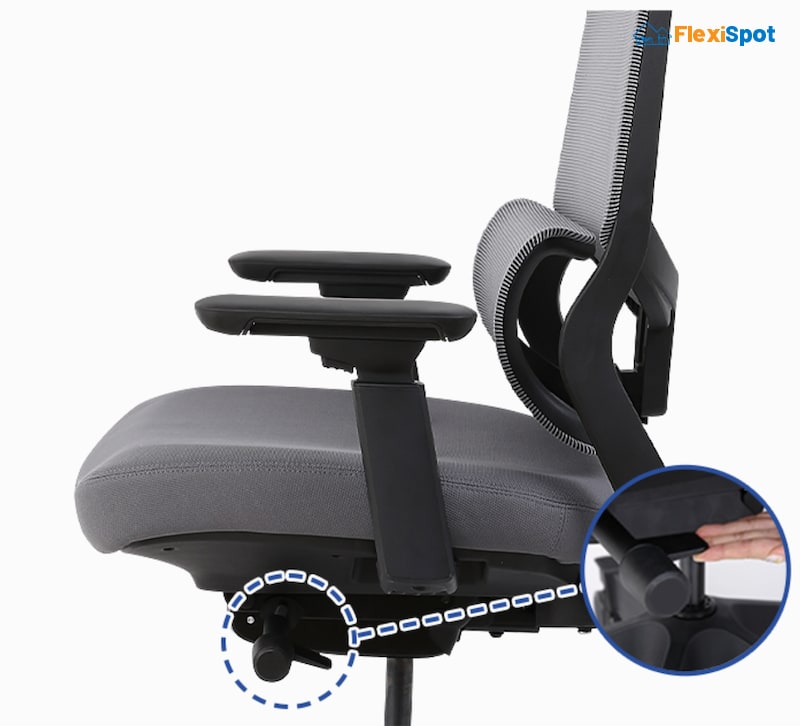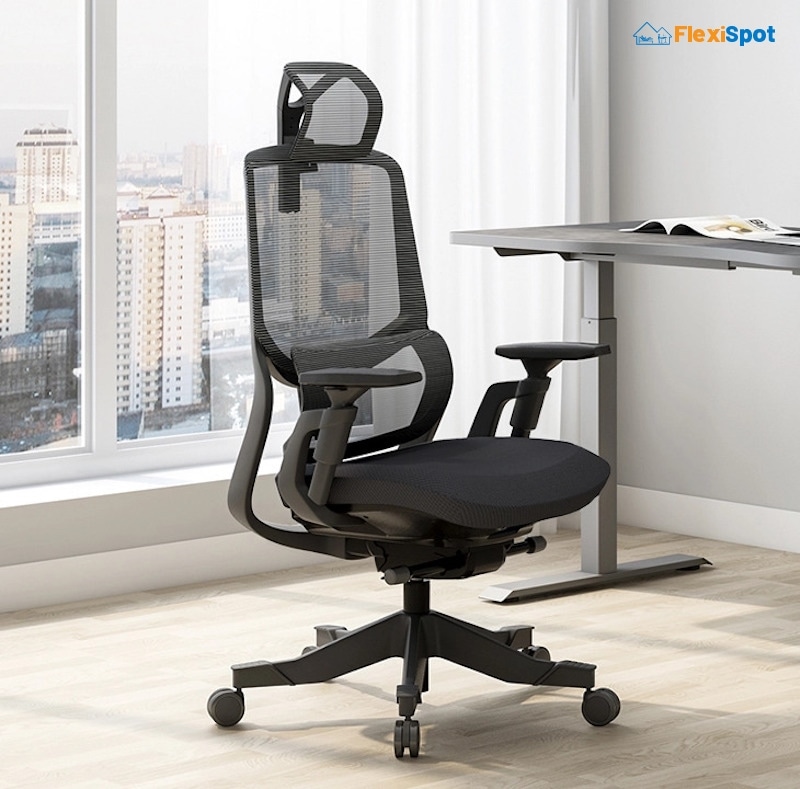The tilt mechanism in office chairs is an important ergonomic feature for a healthy, proper spine and back alignment. The tension and strength in the tilt mechanism are what make sure that your back remains supported.
But there is more than just one type of tilt mechanism available. With how much sitting the average person does nowadays, such features are necessary for our furniture. We spend a very large chunk of our day sitting in general, and a good 8 hours or so are spent at our desks.
That means we definitely need a good chair to keep us supported! Since different chairs come with different types of tilts and features, you’d have to pick out the right kind of chair for you to ensure your long-term comfort.
Here we have the different types of tilt mechanisms on office chairs explained.
Types of Office Chair Tilt Mechanisms
Office chairs will ideally have a tilting function since this helps you recline in your seat while you work. When you have to spend a long time in the same spot, the stress develops in your body and your blood flow is not as great as it should be. Having a seat that reclines and rocks allows you to overcome these issues.
Synchronous Tilt
For office chairs with a synchro tilt mechanism, the backrest is linked with the seat, but they tilt independently depending on where you lean. The recline on such chairs is usually set at a fixed ratio of 2:1 when you lean back, which means that every 8 degrees your backrest reclines, your seat moves by 4 degrees.
Adjustments for office chairs are usually placed under the seat, so you can make your adjustments easily without getting out of the chair. Synchro office chairs also have a ‘waterfall seat’ design. This is a feature that helps minimize how much stress is placed on your thighs as you lean back. On top of that, it stimulates blood circulation and reduces the amount of stress in your lumbar region as well.
Single Point Tilt
This is the tilt that is most commonly found on your regular office chairs. The tilt in this mechanism is a fairly basic one, located at the back or the center of the seat of the chair. This tilts the backrest and the seat pan at a 1:1 recline ratio.
While for smaller tilts this works fine, it is not the ideal option for chairs with a tilt greater than 5 to 10 degrees. Because the backrest and seat pan angle change at the same rate, when you recline, there may be added pressure on the underside of your thighs, which can cause pain in some situations.
Knee Tilt Mechanism
For chairs with a knee tilt mechanism, the pivot is closer to the front of the seat, which means that the tilt gets a wider angle, while the seat still remains around the same spot. Most executive chairs have this kind of tilting mechanism and are somewhat of a merger between single point and synchronous tilts.
The pivoting point being at the front of the seat would mean that your feet would remain on the ground, even if you recline the backrest as far back as it can go. While this works great for many chairs, it does come with the downside of not having good seat depth adjustment, because the pivot location doesn’t allow such a feature to be added.
Forward Tilt Mechanism
Another tilting mechanism commonly found in office chairs is the forward tilt. This is where the front of the seat is what is tilted up and down. Because the seat is forward sloping, the blood flow to the lower body is increased while you sit, and there is reduced lower back pressure. There is also significantly less pain as you lean forward.
But while common, the forward tilt is not usually found on its own. It is often used as a part of a multi-tilt mechanism with a number of other adjustments. As an ergonomic solution, forward tilting chairs are an excellent option.
Forward Glide Tilt Mechanism
The forward glide tilt is slightly different from the forward tilt. In this, the seat pan adjusts forward tilts downwards as the backrest reclines.
This is different from the other tilt mechanisms we’ve mentioned so far because in all the others, the seat pan and backrest tilt in the same direction. In this case, the seat pan moves in the opposite direction, and downward as the backrest reclines, rather than reclining backward with it.
The forward glide mechanism is great because it keeps your lower body at the slight inclination it needs to stay ergonomically appropriate. It also makes sure that your arms and eye level remain within the natural zone, even if you recline your backrest heavily.
Since the ideal backrest angle is about 135 degrees for people who suffer from back pain, this is great for folks who suffer from such.
Seat Angle Lock Mechanism
The last type is the seat angle lock mechanism. This is ideal for when you’re working in a reclined position because this way your entire body stays angled upwards, instead of your back.
In almost all other office chair tilt mechanisms, the backrest angle is usually the only one that can be locked in. This means that if you stop applying pressure to the backrest, your seat goes back to the usual, level angle.
When you have to spend a lot of time working, consistently putting pressure on the backrest can get tiring, but without the seat angle, you’d get tired because of the pressure on your thighs. A seat angle lock mechanism helps with this because you can lock the seat and the backrest angle while you work, and thus reduce the pressure on your back.
Mechanism Free Tilt
Some chairs have tilt but come without any real tilt mechanism involved. This is also called weight-activated tilt. With these chairs, you can’t get a lot of adjusting options besides the seat height adjustment.
This is because, with weight-activated tilt chairs, you don’t actually have to do any of the adjustments yourself. When you sit in the chair and adjust the height depending on your height and weight, the weight-activated mechanism within the seat automatically adjusts the recline of the chair to make sure you remain in an ergonomic position.
The caveat here is that you’d need to adjust the height of the seat to the correct position for this to work properly. This mechanism also helps reduce the weight of the chair itself, which makes it easier to handle.
Flexispot Soutien Ergonomic Chair
Flexispot’s Soutien office chair is an ergonomic office chair with a tilt mechanism, designed to keep you in a comfortable position while you work so that you don’t end up with unnecessary pain.
The chair comes with three height adjustment levels with a rebound system so you can keep your wrist in the correct position and avoid straining it too much. This also keeps your neck protected from stress.
Because the backrest curves ergonomically, you can make sure your back and spine are also protected, and you don’t have to lean forward or hunch over while you’re working. The backrest also has a 45-degree backrest tilt that lets you recline comfortably while you work. The seat of the chair tilts up near the front, which allows you to increase the depth of the chair and find a comfortable position for your body.
The chair comes with a cushioned armrest which is adjustable in four dimensions. This can again help with keeping your wrist positioned correctly and avoiding strain.
Because these armrests contour to your arms and elbows, you can also rest assured that all the moving around you’ll have to do with your mouse won’t be too much of a problem. The cushioning also make sure your elbows don’t start to hurt after a while and your wrist stays comfortable.
The Soutien chair is made from breathable and temperature-sensitive mesh. This provides ventilation and keeps you comfortable while you work. The mesh is also flexible, so it can adjust with your body as you relax in it.
Ergonomic chairs don’t just cater to one specific aspect of your wellbeing but are designed to make sure all parts of your body stay comfortable and protected while you work. This is why Flexispot emphasizes different kinds of ergonomic furniture.
With a little bit of extra care and an ergonomic chair like the Soutien, you can avoid the pesky wrist pain that makes your life hard, and keep yourself working comfortably for much longer.

